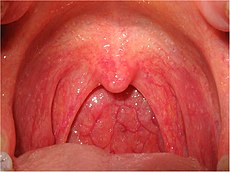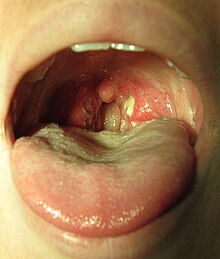| Pharyngitis | |
|---|---|
| Classification and external resources | |
 Inflammed oropharynx: swollen and red. | |
| ICD-10 | J02., J31.2 |
| ICD-9 | 462, 472.1 |
| DiseasesDB | 24580 |
| MedlinePlus | 000655 |
| eMedicine | emerg/419 |
| MeSH | D010612 |
Like many types of inflammation, pharyngitis can be acute – characterized by a rapid onset and typically a relatively short course – or chronic. Pharyngitis can result in very large tonsils which cause trouble swallowing and breathing. Pharyngitis can be accompanied by a cough or fever, for example, if caused by a systemic infection.
Most acute cases are caused by viral infections (40–80%), with the remainder caused by bacterial infections, fungal infections, or irritants such as pollutants or chemical substances.[2][3] Treatment of viral causes are mainly symptomatic while bacterial or fungal causes may be amenable to antibiotics and anti-fungal respectively.
Contents
|
Classification
Pharyngitis is a type of inflammation, most commonly caused by an upper respiratory tract infection. It may be classified as acute or chronic. An acute pharyngitis may be catarrhal, purulent or ulcerative, depending on the virulence of the causative agent and the immune capacity of the affected individual. Chronic pharyngitis is the most common otolaringologic disease and may be catarrhal, hypertrophic or atrophic.If the inflammation includes tonsillitis, it is called pharyngotonsillitis.[4] Another sub classification is nasopharyngitis (the common cold).[5]
Cause
The majority of cases are due to an infectious organism acquired from close contact with an infected individual.Infectious
- Viral
- Adenovirus – the most common of the viral causes. Typically the degree of neck lymph node enlargement is modest and the throat often does not appear red, although it is very painful.
- Orthomyxoviridae which cause influenza – present with rapid onset high temperature, headache and generalised ache. A sore throat may be associated.
- Infectious mononucleosis ("glandular fever") caused by the Epstein-Barr virus. This may cause significant lymph gland swelling and an exudative tonsillitis with marked redness and swelling of the throat. The heterophile test can be used if this is suspected.
- Herpes simplex virus can cause multiple mouth ulcers.
- Measles
- Common cold: rhinovirus, coronavirus, respiratory syncytial virus, parainfluenza virus can cause infection of the throat, ear, and lungs causing standard cold-like symptoms and often extreme pain.
- Bacterial
- Streptococcal pharyngitis
Main article: Streptococcal pharyngitis
Streptococcal pharyngitis or strep throat is caused by group A beta-hemolytic streptococcus (GAS).[7] It is the most common bacterial cause of cases of pharyngitis (15–30%).[6] Common symptoms include fever, sore throat, and large lymph nodes. It is a contagious infection, spread by close contact with an infected individual. A definitive diagnosis is made based on the results of a throat culture. Antibiotics are useful to both prevent complications and speed recovery.[8]- Fusobacterium necrophorum
- Diphtheria
- Others
- Fungal
Non-infectious
Pharyngitis may also be caused by mechanical, chemical or thermal irritation, for example cold air or acid reflux. Some medications may produce pharyngitis such as pramipexole and antipsychotics.[13][14]Diagnostic approach
It is hard to differentiate a viral and a bacterial cause of a sore throat based on symptoms alone. Thus often a throat swab is done to rule out a bacterial cause.[15]Management
The majority of time treatment is symptomatic. Specific treatments are effective for bacterial, fungal, and herpes simplex infections.Medications
- Analgesics such as NSAIDs and acetaminophen can help reduce the pain associated with a sore throat.[16]
- Steroids (such as dexamethasone) have been found to be useful for severe pharyngitis.[17][18]
- Viscous lidocaine relieves pain by numbing the mucus membranes.[19]
- Antibiotics are useful if group A streptococcus is the cause of the sore throat. For viral infections, antibiotics have no effect.[20]
 Unknown
Unknown









0 komentar:
Post a Comment